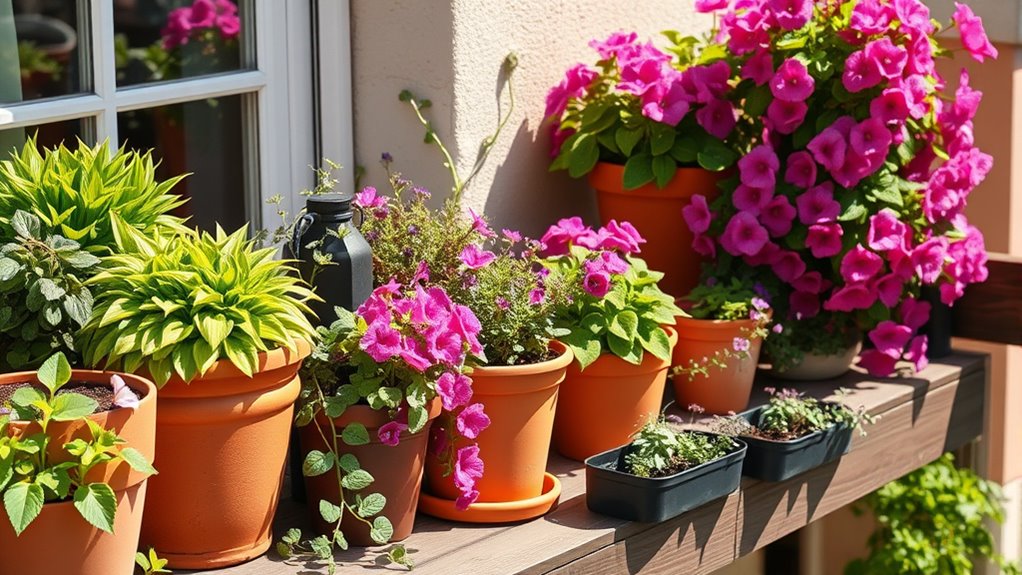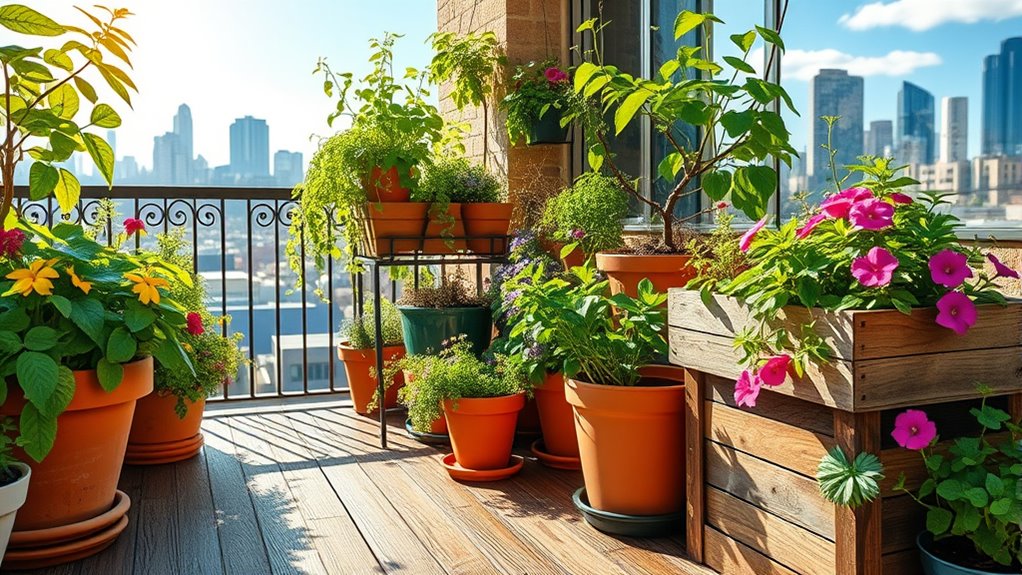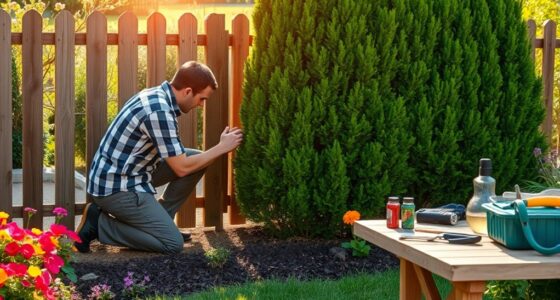Container gardening is a great way to turn your patio or balcony into a lush, vibrant space. You can grow a variety of plants in small or large containers, adding personal style and greenery to your outdoor area. Using efficient watering systems and choosing pest-resistant plants helps keep them healthy. Understanding local codes, choosing quality soil, and regular care ensure success. Keep exploring to discover more tips that will help your container garden thrive.
Key Takeaways
- Utilize container gardening to transform small patios and balconies into vibrant green spaces.
- Implement efficient irrigation systems like drip or self-watering containers for consistent plant watering.
- Regularly inspect for pests and use organic methods to maintain healthy, pest-free plants.
- Comply with local building codes and select quality soil amendments to support plant growth.
- Maintain consistent care and attention to ensure a lush, colorful, and thriving balcony or patio garden.

Have you ever considered transforming small spaces into lush, vibrant gardens? Container gardening makes that possible, turning patios and balconies into green retreats. Whether you have a tiny balcony or a spacious terrace, you can create a thriving garden by choosing the right containers and plants. One of the keys to success is setting up efficient irrigation systems, which guarantee your plants receive consistent watering without overdoing it. Drip irrigation or self-watering containers are excellent options, helping you save time and water while keeping your plants healthy. Proper watering is especially important in containers because soil tends to dry out faster than in-ground gardens. Installing an irrigation system takes the guesswork out of watering, allowing you to enjoy your garden without constant maintenance. Regular monitoring of your plants is also essential to catch early signs of pests or diseases. Beyond watering, pest management is another vital aspect to keep in mind. Container gardens are often exposed to the elements and can be more vulnerable to pests like aphids, spider mites, or whiteflies. Regular inspection of your plants helps you catch problems early. You can prevent infestations by choosing pest-resistant plant varieties or introducing natural predators like ladybugs. If pests do appear, treat issues promptly with organic solutions such as neem oil or insecticidal soap, avoiding harsh chemicals that can harm beneficial insects or compromise your plants’ growth. Good airflow and proper spacing between containers also help reduce the risk of pests and diseases, keeping your garden healthier. Additionally, understanding the importance of building codes and permits can ensure your container garden complies with local regulations and avoids potential issues. Using soil amendments can also improve nutrient retention and drainage, leading to healthier plants.
Ultimately, the success of your container garden depends on diligent care. Implementing effective irrigation systems simplifies watering, while vigilant pest management keeps your plants healthy and thriving. With some planning and regular attention, you’ll enjoy a lush, colorful garden right outside your door. It’s a rewarding way to bring nature into your daily life, even in the smallest of spaces.
Frequently Asked Questions
How Do I Prevent Pests in Container Gardens?
To prevent pests, you should implement effective pest prevention strategies like inspecting plants regularly and removing dead leaves. Use natural pest control methods such as introducing beneficial insects or spraying neem oil. Keep your containers clean, avoid overwatering, and guarantee good airflow to minimize pest habitats. By staying vigilant and applying these natural techniques, you can protect your plants without resorting to harsh chemicals, ensuring a healthy, thriving garden.
What Are the Best Container Materials for Different Plants?
When choosing containers, focus on plant material selection and container durability to suit each plant’s needs. For lightweight options, go for plastic or resin, which are easy to move and resist weather. If you want a natural look, choose clay or ceramic, but remember they can crack in cold weather. For outdoor durability, opt for metal or treated wood. Always match the container to your plant’s watering and stability requirements.
How Often Should I Water My Patio Plants?
Your watering schedule depends on the plant type, container size, and weather conditions. Usually, you should water when the top inch of soil feels dry, ensuring proper plant hydration. During hot or windy days, you might need to water more frequently, while cooler weather may require less. Keep an eye on your plants, and remember, consistent watering helps maintain healthy growth and prevents stress.
Can I Grow Vegetables in Small Balcony Containers?
Yes, you can grow vegetables in small balcony containers. Focus on compact varieties suited for container gardening, and consider plant height considerations to maximize space. Companion planting helps improve growth and repel pests, so mix compatible vegetables. Use sturdy containers with good drainage, and guarantee they get enough sunlight. Regular watering and fertilizing are key to healthy plants. With proper planning, your small balcony can yield fresh, delicious vegetables.
How Do I Ensure Proper Drainage in Container Pots?
Imagine your container as a mini ecosystem—proper drainage keeps it balanced. To guarantee this, use soil amendments like perlite or coarse sand to improve drainage. Always add a layer of gravel or broken pottery at the bottom of your pot. When watering, do so slowly to prevent waterlogging, allowing excess water to escape freely. This combination helps your plants thrive without root rot or oversaturation.
Conclusion
Think of your container garden as a tiny, vibrant island, each pot a lush cove teeming with life. With your care, these miniature landscapes thrive, turning your patio or balcony into a thriving island oasis. Just as a gardener tends to each plant, you nurture your personal paradise, watching it flourish and bloom. Embrace this journey, and soon, your small sanctuary will be a lush, colorful haven, inviting nature’s beauty right to your fingertips.









